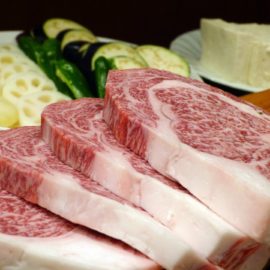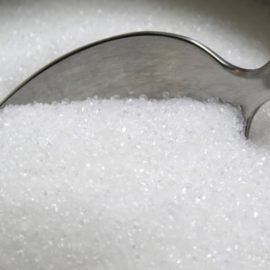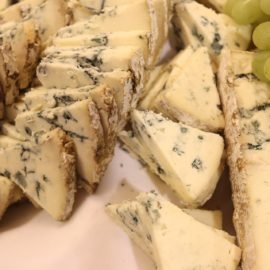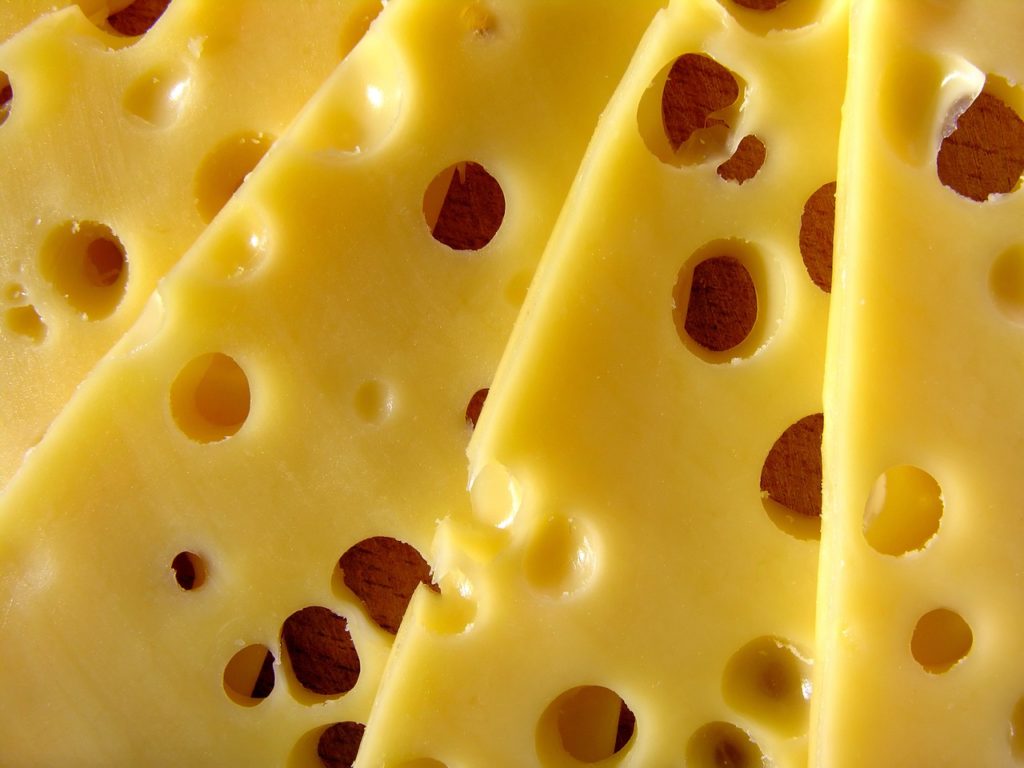
Cheese is primarily made from milk, specifically the milk of cows, goats, sheep, or buffalo. The milk is typically coagulated or curdled, which causes it to separate into solid curds and liquid whey. The curds are then processed and transformed into cheese through various methods, depending on the type of cheese being produced.
Now if cheese is primarily made from milk, which is white in color, why is cheese yellow, then?
Well, most cheese, in general, is yellow because of natural pigments called carotenoids.
The main providers of milk for cheese production are cows, and their diet typically consists of grass, hay, or silage. These feed sources contain carotenoids, specifically beta-carotene, which acts as a precursor to vitamin A and contributes to an orange-yellow hue in cheese.
During digestion, cows convert beta-carotene into vitamin A, which then gets stored in their body fat. When milk is produced, the fat globules carry some of these fat-soluble pigments, including the yellow-orange carotenoids, into the milk.
Let’s discuss further.
WHAT ARE CAROTENOIDS?
Carotenoids are a group of naturally occurring pigments found in various plants, algae, and some bacteria. They are responsible for the vibrant red, orange, and yellow colors seen in fruits, vegetables, and other natural substances. Carotenoids play important roles in both photosynthesis and the diet of organisms.
Structurally, carotenoids consist of a series of conjugated double bonds and are classified into two major groups: carotenes and xanthophylls. Carotenes are hydrocarbons, while xanthophylls have oxygen-containing functional groups. Common carotenoids include beta-carotene, lycopene, lutein, and zeaxanthin.
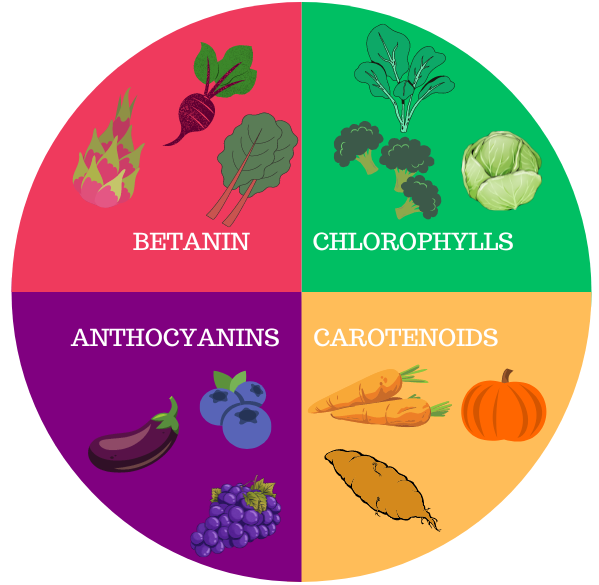
In milk, the most prominent carotenoid in milk is beta-carotene, which is primarily found in the milk fat globules. Beta-carotene is a precursor to vitamin A and is widely present in various fruits, vegetables, and other natural sources.
One of the primary functions of carotenoids in plants is their involvement in photosynthesis. They act as accessory pigments, capturing light energy that chlorophyll alone cannot absorb. By absorbing light across a broader range of wavelengths, carotenoids help optimize the energy-harvesting efficiency of plants.
Carotenoids also serve as antioxidants, protecting plants from the damaging effects of excessive light and reactive oxygen species. They help neutralize free radicals and prevent oxidative stress, which can cause cell damage and contribute to aging and disease.
WHITE MILK TO YELLOW CHEESE
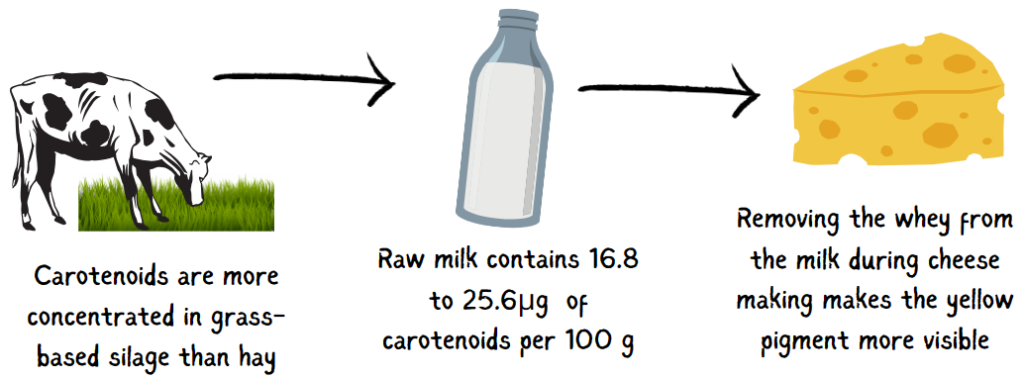
Carotenoids end up in milk through the diet of the animals producing the milk. Carotenoids are naturally present in various plants, particularly in green, leafy vegetables and fruits. This is why grass-based silage contains more carotenoids than hay. When a cow consumes these carotenoid-rich plants, the carotenoids are absorbed into its bloodstream.
Once absorbed, carotenoids are then transported to various tissues and organs, including the mammary glands, where milk production takes place.
During the cheese-making process, the carotenoids become more concentrated and visible. Here’s how.
You might also like: The Chemistry of Cheese Ripening
When the milk is coagulated using rennet or bacterial cultures, the curds separate from the liquid whey. Within the curds, the fats and proteins encapsulate the carotenoids. These carotenoids are initially dispersed throughout the milk, but as the curds form, they become more concentrated within the solid portion.
The next crucial step is draining the whey from the curds. As the whey is removed, the remaining curds become denser and more concentrated. Consequently, the carotenoids, including beta-carotene, which is a prominent yellow-orange pigment, become more pronounced and visible within the curds.
Additionally, as the curds are processed further, such as through heating, cutting, and pressing, the concentration of carotenoids continues to increase. The manipulation of the curds during these stages aids in expelling excess whey, compacting the curds, and consolidating the cheese. The increased concentration of carotenoids intensifies the yellow color of the cheese. The yellow color is more intense if the milk was obtained from a cow that graze on fresh silage.
WHAT’S WITH WHITE AND ORANGE CHEESES?

While the majority of cheeses are naturally yellow, some are white or orange in color.
Certain orange-colored cheeses are mostly owing to the addition of annatto, a natural food coloring. Annatto is obtained from the seeds of the achiote tree, and is widely used to provide an orange tint to cheese. The amount of annatto used determines the intensity of the orange color. Some cheeses that are orange in color are:
- Red Leicester: Red Leicester is a British cheese that is typically made with cow’s milk. It has a firm texture and a nutty, mellow flavor.
- Colby: Colby cheese is a semi-hard American cheese that is slightly milder than cheddar. It is often used in sandwiches, snacks, and grated over dishes.
- Gloucester: Gloucester cheese is a traditional English cheese that comes in two varieties: Single Gloucester and Double Gloucester. It has a mild, creamy flavor.
Certain cheeses, such as cottage cheese and feta, maintain their white appearance due to their higher acidity levels. These cheeses possess dense protein structures. This denser protein network prevents the absorption or retention of colorants or pigments that might be present in the milk. For this reason, they maintain their original white appearance.
Another reason for the whiteness of certain cheeses is the type of milk used. Cheeses made from the milk of animals like goats and water buffalo, such as goat cheese and buffalo mozzarella, exhibit a white coloration. This is because these animals do not store beta carotene in their fat. Instead, they convert beta carotene into colorless vitamin A. As a result, the cheeses produced from their milk do not acquire a yellow color.
